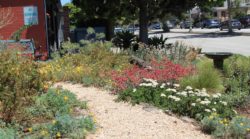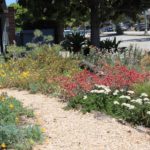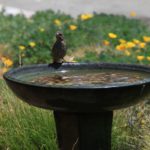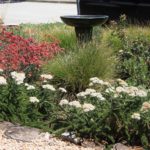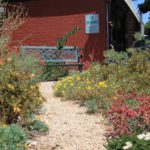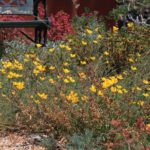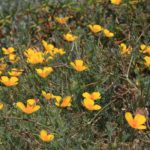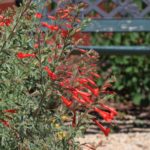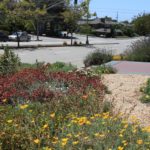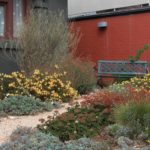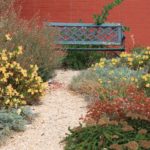Lot size: 500 sq. ft. front garden, 100% native
Garden Age: Garden was installed in 2021
Years on the Bringing Back the Natives Garden Tour: New this year!
Showcase Feature
Though small, this inviting garden has it all; great plants for wildlife, water for thirsty creatures, and a seating area from which plant lovers can enjoy the colorful display of flowers and varying textures of the diverse array of plants selected by Donna Bodine of BeeLand Farms, in consultation with Lauren Jelks.
The gracefully curving gravel path is bordered by birch stumps, salvaged when a neighbor removed a tree, and drifts of rosy pink buckwheat, fire-engine red fuchsia, creamy yarrow, and low-growing, yellow coastal poppy. These low-growing plants are perfectly in scale with the size of the garden.
Other Garden Attractions
• The dense planting outcompetes weeds.
• Clustered field sedge, and two kinds of fescue—California and Idaho—create a sense of naturalness that is the perfect complement to the buoyant blooms on the more colorful plants.
• The garden is watered with a drip irrigation system.
• Stroll around the corner to Julie Benson’s garden on Hampel Street.
• Designer Donna Bodine will be at this garden throughout the day to answer questions.
Gardening for Wildlife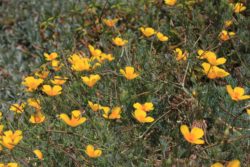
Hutton’s vireo, robins, and finches flit search about for insects and seeds, and drink from and bathe in the bird bath. Mourning doves, which mate for life, nest in the garden. Monarch butterflies lay their eggs on our own local native narrow leaf milkweed, Asclepius fascicularis—the only plant they can lay their eggs on—and their colorful caterpillars happily chawed down on the milkweed—the only plant they can eat. A log provides shelter for small creatures that need dampness and shade.
Keystone species in this garden (watch this talk by Doug Tallamy!)
Keystone species—our own, local ecological powerhouse plants— in this garden include manzanita, sage, buckwheat, and lupines.
Green Home Features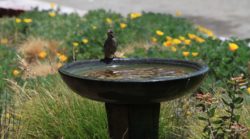
When Alton replaced his roof he installed a light-colored one; light colored roofs reflect most of the sunlight that hits them, whereas dark-colored roofs absorb that heat. A light-colored roof will keep your house cooler and you more comfortable, lower your energy bills if you have an air conditioner, and last longer than a dark roof.
If installed throughout an urban area, light-colored, or “cool” roofs have the potential to mitigate the urban heat island effect—where heat is absorbed by dark roofs, making urban areas hotter than they otherwise would be.
Alton also has solar panels, which help reduce his PG&E bill.
Parking
Parking is available at the church on the corner of Hampel and Park; the parking lot entrance is on Hampel.


